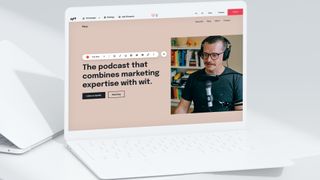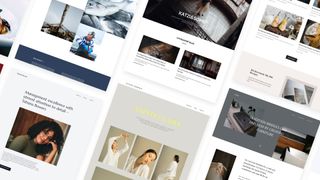Zyro interview: website building, the new normal, and more
We get an inside look at Zyro's biggest successes and challenges during COVID-19, and where the website builder is headed now

Zyro is one of the platforms vying to be named best website builder, especially for beginners and businesses that are looking for something that “just works”, and want to get a website off the ground in a few minutes. It’s made our list thanks in large part to its inexpensive plans, simple drag-and-drop editor, and reliability.
We caught up with Giedrius Zakaitis, CEO at Zyro, to get the lowdown on some of Zyro’s biggest successes, and how the business has adapted to the COVID-19 pandemic. We also learned more about how Zyro is leveraging new technology to improve the user experience, and the company’s plans for the future.
Can you give us a brief overview of the company and what it does?
At its heart, Zyro is a website builder that aims to lower the bar for sole entrepreneurs, small businesses, and private individuals to establish an online presence. This means code-free web design, accessible to beginners but with professional results.
However, from its inception, we’ve always had in our mind that we want Zyro to go beyond what other website builders offer, to become the first true online success builder.
This is why, as well as developing what we believe is one of the most accessible and functional builders available online, we have at the same time developed a number of branding and marketing tools, many of them based on new artificial intelligence technology.
Zyro is quickly becoming a one-stop solution for not just creating a website, but developing a brand identity, finding an audience, and driving success. We offer an affordable website and marketing resources that are almost as good as an agency would provide, at a fraction of the cost.
What's been your biggest success, and why?
In terms of the product itself, the jewels in Zyro’s crown (currently) are our AI business tools. It’s no secret that we benefit from our close relationship with our parent company, Hostinger. Being able to learn from data pulled from millions of live websites hosted by Hostinger has supercharged our AI capabilities.
Get the ITPro. daily newsletter
Receive our latest news, industry updates, featured resources and more. Sign up today to receive our FREE report on AI cyber crime & security - newly updated for 2024.
Our users can take advantage of tools that help them create a unique logo, or even generate search-optimised copy - all with the power of AI. These are essential time and money-saving tools for small businesses. I cannot express how satisfying it has been to develop the AI tools, and see that they really make it much easier for our customers to achieve their online success.
Beyond the product, however, I think it’s worth highlighting that the secret to our success so far - as I see it - has been embracing our customer obsession within the team, and building all of our processes with this in mind.
We make sure that there are clear channels of communication between our customer-facing teams and our product team. This means that all the conversations and feedback we receive via customer service or across social media are directly shaping our roadmap.
We’ve watched our internal metrics and customer happiness constantly increase because of this approach.
What have been the biggest challenges, and how did you tackle them?
Honestly, I think you’d have to look right when we were starting out. Choosing the right technical solutions (architecture) for the foundation of Zyro was quite challenging.
We built three different proofs of concept until we understood and committed to what would be the best solution for the long term. We were clear-sighted from the outset that we needed to stay on top of web standards while maintaining ease of use for the customers.
We also knew that we needed to choose a solution that would support the steady, consistent, and iterative development of our platform; something that would allow us to create a credible MVP version of our builder, but that would not present any limitations as we grew.
Looking back, the timing couldn’t have been better, as CSS grid was getting support from all the major browsers around that time. This was a clear choice once we settled on it.
What impacts - both positive and negative - has the pandemic had on your business?
Thinking about the positive, let’s not ignore the fact that the pandemic galvanised a blossoming of entrepreneurship. Millions of people saw it as an opportunity to launch new companies, try out side-gigs, and turn long-held business ideas into reality.
While this trend may have served us better a little later, when our market position was more secure, rising tides lift all ships. What better time to move into the website builder space with a product designed for small businesses and sole entrepreneurs?
In terms of negative, it depends on your perspective. When the pandemic first hit and we were facing lockdown, the entire Zyro team was still only a couple of dozen people. The majority of our growth as a company has taken place during some version of lockdown.
Initially, I was worried that having a team that was wholly or mostly remote at this crucial time would limit growth and impact cohesion. Many colleagues working on the same teams had only met each other in person once or twice, often only in summer 2021, so it certainly would have been nice for this to happen sooner.
However, my concerns seem to have been unwarranted. We have a lively Slack and regular Zooms, and have mastered the art of remote team building. At this point, working together in the office is just a bonus.

What new market challenges and opportunities have you seen emerge?
I don’t think the key challenges we face are unique to us, or even to our industry. Being the offspring of a major hosting company means that we understand better than most the dangers of lax cybersecurity. We recognise that it’s not just our organisation’s work and data at stake if we drop the ball on safety, but that of all our users, so this remains a primary concern for us.
I suppose that is also just a part of the other two main challenges we face, namely providing a solid customer experience and nurturing loyalty. No startup will ever succeed without putting a foot wrong at some point along the way, especially in their first years.
However, when you’re taking the responsibility for thousands of customers’ online success on your shoulders, a single foot wrong can have significant consequences.
I’d frame the opportunities ahead of us within the same customer success paradigm. What our users want is a fully functional online presence. A website alone isn’t good enough in 2021; small businesses need cross-channel marketing and communication, and often a sales solution to find success.
This comprehensive approach is important horizontally—across all kinds of business—not just within a single vertical. By creating the tools and leaving room for infinite flexibility, we’re making online success accessible to all.
Are you taking advantage of the new world of blended and remote working? If so, how?
I love our team and am proud of the amazing culture we managed to grow in such a short amount of time. Having the foundation of a great work culture and an engaged team allowed us to work even more productively after COVID started and we went remote.
I guess here I should describe the hiccups we experienced as we pivoted to working away from the office, but honestly, the transition was so smooth that there’s really nothing I can point to, other than missing out on office culture and coffee machine chats.
We’re an international team anyway, so in a way, we were already prepared to face any of the challenges posed by remote working. Now that we’re slowly returning to the office, we’re obviously enjoying the advantages that a dedicated workspace and in-person interaction offer, so we’ll stick to the hybrid model.
What are your aims for the future?
Our plan is the same as it has always been: listen to our users, understand their needs, and build quality solutions to the challenges they face. I know most companies will claim to base decisions on client needs, but we take the concept to the next level.
We regularly update our company roadmap, where all our users can see what new feature we’re planning or currently have in development. For every single feature on that road map, I can point to at least one interaction with a customer where they have requested that functionality.
Right now, we’re focusing on creating specialised tools to improve our builder’s utility for specific industries. A recent example was slideshows designed to showcase photography work, and the team is working on booking forms for hotels, hairdressers, and other businesses.
It might sound like we're only being reactive, but we’re really just sticking consistently to the same approach.
How do you see the website builder sector changing in the next five to 10 years?
First and foremost, it will be dominated by Zyro. Well, that’s obviously what I hope anyway.
Perhaps being more clear-sighted, it’s pretty safe to say that the shift online is not temporary—this is the new normal. This unprecedentedly swift change represents a big enough opportunity for many website or ecommerce builder platforms to succeed.
In effect, the market will grow at such a rate that it will be able to sustain a number of large players, and users will benefit from the greater choice and broader range of functionality. Pay what you can afford for the tools you need. We are in the very early days of capitalising on this opportunity, and we believe that the time for growth is just beginning.
Further reading
Hostinger offers the Zyro website builder, among the best website builders available, for site construction: read our comprehensive Zyro review to find out more, and our interview with Hostinger CEO Giedrius Zakaitis about the company's biggest successes, challenges, and plans for the future.
Christian is a freelance writer and content project manager, with over six years' experience writing and leading teams in finance and technology for some of the world's largest online publishers, including TechRadar and Tom's Guide.





